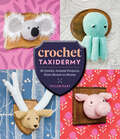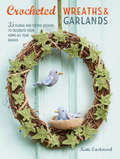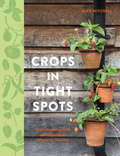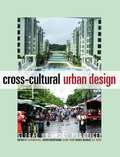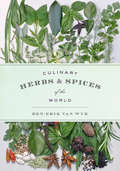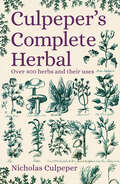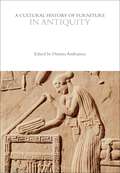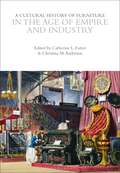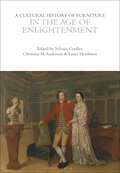- Table View
- List View
Crochet Taxidermy: 30 Quirky Animal Projects, from Mouse to Moose
by Taylor HartFoxes, cows, jellyfish, owls, skunks, deer, and more come alive in these 30 whimsical projects that are crocheted using the popular amigurumi technique, then mounted for display as unique conversation starters and home decor. Easy to make and bursting with tongue-in-cheek humor.
Crocheted Wreaths and Garlands: 35 floral and festive designs to decorate your home all year round
by Kate EastwoodCrochet beautiful home decorations in a contemporary style with these 35 patterns for every season, special occasions, holidays, and all year round.Kate Eastwood was taught to knit as a child, by her mother, but seven years ago she decided to teach herself how to crochet. Since then she has shared her love of all things crochet on her blog, justpootling.blogspot.co.uk. This is her first book, but Kate has also designed projects for lovecrochet.com and Simply Crochet magazine. Kate lives near Bath, UK, with her husband and their two Weimeraners.
Crocheted Wreaths and Garlands: 35 floral and festive designs to decorate your home all year round
by Kate EastwoodCrochet beautiful home decorations in a contemporary style with these 35 patterns for every season, special occasions, Christmas, and all year round.Kate Eastwood has designed 35 colourful and natural-looking wreaths and garlands just for you, with something to suit every occasion and every place. There are garlands with flowers and foliage that won't fade after a few days, and wreaths that can be kept on display all year round, not just for Christmas. You can crochet a Heart Garland for Valentine’s Day, or an Easter Egg Wreath full of the colors of spring. In summer, a wreath covered in bright strawberries will brighten up your hallway. For the autumn, a ring of crocheted pumpkins will look great on your front door, and for Christmas there’s everything from a Mistletoe Wreath to a Gingerbread Garland. If you want a make that will look good all year round, try the Bobble Bunting in strong pastels, or the Shaker Birdhouse Garland in soft, neutral shades to suit any room.
Crops in Tight Spots
by Alex MitchellShort of outdoor space but want to grow fruit and vegetables? Congratulations. Really, lucky you. Not for you the back-breaking trudge of tending large spaces of land, the weeding, digging and pest vigilance. Gluts? They will mean nothing to you. Instead you can look forward to small but perfectly formed bursts of flavour. Handfuls of fresh leaves, berries and tomatoes, just when you want them, and at arm's reach. As more of us live in cities with restricted outside spaces, growing food becomes all the more important, not just for the delicious results, but as a mindful way to connect us to the seasons and to nature. Full of tried-and-tested, fool-proof crop ideas exclusively tailored for containers, raised beds and small gardens, Crops in Tight Spots guarantees vegetable growing success for even the most newbie of gardeners and limited of spaces.
Cross-Cultural Urban Design: Global or Local Practice?
by Catherin Bull Davisi Boontharm Claire Parin Darko RadovicUnprecedented in its scope, Cross-Cultural Urban Design: Global or Local Practice? explores how urban design has responded to recent trends towards global standardisation. Following analysis of its practice in the local domain, the book looks at how urban planning and design should be repositioned for the future. It looks at:population movement urb
Cross-Cultural Urban Design: Global or Local Practice?
by Catherin Bull Davisi Boontharm Claire Parin Darko Radovic Guy TapieUnprecedented in its scope, Cross-Cultural Urban Design: Global or Local Practice? explores how urban design has responded to recent trends towards global standardisation. Following analysis of its practice in the local domain, the book looks at how urban planning and design should be repositioned for the future. It looks at:population movement urb
Cross section through a leaf (large print)
by RnibThis is a labelled cross section diagram showing some of the various parts and types of cell in a plant leaf and some of their functions. There is a locator dot shown, which will be at the top left of the page when the image is the correct way up. The labels are on the left of the page, pointing to the parts of the leaf in the diagram on the right.
Cross section through a leaf (UEB contracted)
by RnibThis is a labelled cross section diagram showing some of the various parts and types of cell in a plant leaf and some of their functions. There is a locator dot shown, which will be at the top left of the page when the image is the correct way up. The labels are on the left of the page, pointing to the parts of the leaf in the diagram on the right.
Cross section through a leaf (UEB uncontracted)
by RnibThis is a labelled cross section diagram showing some of the various parts and types of cell in a plant leaf and some of their functions. There is a locator dot shown, which will be at the top left of the page when the image is the correct way up. The labels are on the left of the page, pointing to the parts of the leaf in the diagram on the right.
Crossing Borders: International Exchange and Planning Practices (RTPI Library Series)
by Patsy HealeyThe complex diffusion processes affecting the flow of planning ideas and practices across the globe are illustrated in this book. It raises questions about why and how some ideas and practices attract international attention, and about the invention processes which go on when external influences are woven together with local efforts to meet local specifics and requirements. Initiated to celebrate the tenth anniversary of the journal Planning Theory and Practice in 2009, this book reflects the themes of the journal. Taking different intellectual perspectives, this collection takes a critical look at the international diffusion of planning ideas and practices, their impacts on planning practices in different contexts, on the challenge of ‘situating’ planning practices, and on the ethical and methodological issues of international exchange in the planning field.
Crossing Borders: International Exchange and Planning Practices (RTPI Library Series)
by Patsy Healey Robert UptonThe complex diffusion processes affecting the flow of planning ideas and practices across the globe are illustrated in this book. It raises questions about why and how some ideas and practices attract international attention, and about the invention processes which go on when external influences are woven together with local efforts to meet local specifics and requirements. Initiated to celebrate the tenth anniversary of the journal Planning Theory and Practice in 2009, this book reflects the themes of the journal. Taking different intellectual perspectives, this collection takes a critical look at the international diffusion of planning ideas and practices, their impacts on planning practices in different contexts, on the challenge of ‘situating’ planning practices, and on the ethical and methodological issues of international exchange in the planning field.
Culinary Herbs and Spices of the World
by Ben-Erik van WykFor centuries herbs and spices have been an integral part of many of the world’s great cuisines. But spices have a history of doing much more than adding life to bland foods. They have been the inspiration for, among other things, trade, exploration, and poetry. Priests employed them in worship, incantations, and rituals, and shamans used them as charms to ward off evil spirits. Nations fought over access to and monopoly of certain spices, like cinnamon and nutmeg, when they were rare commodities. Not only were many men’s fortunes made in the pursuit of spices, spices at many periods throughout history literally served as currency. In Culinary Herbs and Spices of the World, Ben-Erik van Wyk offers the first fully illustrated, scientific guide to nearly all commercial herbs and spices in existence. Van Wyk covers more than 150 species—from black pepper and blackcurrant to white mustard and white ginger—detailing the propagation, cultivation, and culinary uses of each. Introductory chapters capture the essence of culinary traditions, traditional herb and spice mixtures, preservation, presentation, and the chemistry of flavors, and individual entries include the chemical compounds and structures responsible for each spice or herb’s characteristic flavor. Many of the herbs and spices van Wyk covers are familiar fixtures in our own spice racks, but a few—especially those from Africa and China—will be introduced for the first time to American audiences. Van Wyk also offers a global view of the most famous use or signature dish for each herb or spice, satisfying the gourmand’s curiosity for more information about new dishes from little-known culinary traditions. People all over the world are becoming more sophisticated and demanding about what they eat and how it is prepared. Culinary Herbs and Spices of the World will appeal to those inquisitive foodies in addition to gardeners and botanists.
Culinary Herbs and Spices of the World
by Ben-Erik van WykFor centuries herbs and spices have been an integral part of many of the world’s great cuisines. But spices have a history of doing much more than adding life to bland foods. They have been the inspiration for, among other things, trade, exploration, and poetry. Priests employed them in worship, incantations, and rituals, and shamans used them as charms to ward off evil spirits. Nations fought over access to and monopoly of certain spices, like cinnamon and nutmeg, when they were rare commodities. Not only were many men’s fortunes made in the pursuit of spices, spices at many periods throughout history literally served as currency. In Culinary Herbs and Spices of the World, Ben-Erik van Wyk offers the first fully illustrated, scientific guide to nearly all commercial herbs and spices in existence. Van Wyk covers more than 150 species—from black pepper and blackcurrant to white mustard and white ginger—detailing the propagation, cultivation, and culinary uses of each. Introductory chapters capture the essence of culinary traditions, traditional herb and spice mixtures, preservation, presentation, and the chemistry of flavors, and individual entries include the chemical compounds and structures responsible for each spice or herb’s characteristic flavor. Many of the herbs and spices van Wyk covers are familiar fixtures in our own spice racks, but a few—especially those from Africa and China—will be introduced for the first time to American audiences. Van Wyk also offers a global view of the most famous use or signature dish for each herb or spice, satisfying the gourmand’s curiosity for more information about new dishes from little-known culinary traditions. People all over the world are becoming more sophisticated and demanding about what they eat and how it is prepared. Culinary Herbs and Spices of the World will appeal to those inquisitive foodies in addition to gardeners and botanists.
Culinary Herbs and Spices of the World
by Ben-Erik van WykFor centuries herbs and spices have been an integral part of many of the world’s great cuisines. But spices have a history of doing much more than adding life to bland foods. They have been the inspiration for, among other things, trade, exploration, and poetry. Priests employed them in worship, incantations, and rituals, and shamans used them as charms to ward off evil spirits. Nations fought over access to and monopoly of certain spices, like cinnamon and nutmeg, when they were rare commodities. Not only were many men’s fortunes made in the pursuit of spices, spices at many periods throughout history literally served as currency. In Culinary Herbs and Spices of the World, Ben-Erik van Wyk offers the first fully illustrated, scientific guide to nearly all commercial herbs and spices in existence. Van Wyk covers more than 150 species—from black pepper and blackcurrant to white mustard and white ginger—detailing the propagation, cultivation, and culinary uses of each. Introductory chapters capture the essence of culinary traditions, traditional herb and spice mixtures, preservation, presentation, and the chemistry of flavors, and individual entries include the chemical compounds and structures responsible for each spice or herb’s characteristic flavor. Many of the herbs and spices van Wyk covers are familiar fixtures in our own spice racks, but a few—especially those from Africa and China—will be introduced for the first time to American audiences. Van Wyk also offers a global view of the most famous use or signature dish for each herb or spice, satisfying the gourmand’s curiosity for more information about new dishes from little-known culinary traditions. People all over the world are becoming more sophisticated and demanding about what they eat and how it is prepared. Culinary Herbs and Spices of the World will appeal to those inquisitive foodies in addition to gardeners and botanists.
Culinary Herbs and Spices of the World
by Ben-Erik van WykFor centuries herbs and spices have been an integral part of many of the world’s great cuisines. But spices have a history of doing much more than adding life to bland foods. They have been the inspiration for, among other things, trade, exploration, and poetry. Priests employed them in worship, incantations, and rituals, and shamans used them as charms to ward off evil spirits. Nations fought over access to and monopoly of certain spices, like cinnamon and nutmeg, when they were rare commodities. Not only were many men’s fortunes made in the pursuit of spices, spices at many periods throughout history literally served as currency. In Culinary Herbs and Spices of the World, Ben-Erik van Wyk offers the first fully illustrated, scientific guide to nearly all commercial herbs and spices in existence. Van Wyk covers more than 150 species—from black pepper and blackcurrant to white mustard and white ginger—detailing the propagation, cultivation, and culinary uses of each. Introductory chapters capture the essence of culinary traditions, traditional herb and spice mixtures, preservation, presentation, and the chemistry of flavors, and individual entries include the chemical compounds and structures responsible for each spice or herb’s characteristic flavor. Many of the herbs and spices van Wyk covers are familiar fixtures in our own spice racks, but a few—especially those from Africa and China—will be introduced for the first time to American audiences. Van Wyk also offers a global view of the most famous use or signature dish for each herb or spice, satisfying the gourmand’s curiosity for more information about new dishes from little-known culinary traditions. People all over the world are becoming more sophisticated and demanding about what they eat and how it is prepared. Culinary Herbs and Spices of the World will appeal to those inquisitive foodies in addition to gardeners and botanists.
Culpeper's Complete Herbal: Over 400 Herbs and Their Uses
by Nicholas CulpeperFrom Artichoke to Rhubarb- Vine to Hawthorn- The Complete Herbal provides the most comprehensive listings of herbs and their uses in existence. First published over 350 years ago by herbalist and apothecary Nicholas Culpeper, this encyclopaedic guide had an extensive impact on modern holistic medicine. This includes his description of the qualities of foxglove, later used to treat heart conditions. In this illustrated edition, over 400 herbs are described in detail, along with their 'government and virtues', remedies, and cautions. Although much of the medical advice must be taken with a pinch of salt, the engaging tone, enthusiasm, and expertise of the author are irresistible and highly entertaining.
Cult T-Shirts: Over 500 rebel tees from the 70s and 80s
by Michael Reach Phoebe MillerSeminal and subversive. Iconic and experimental. Radical and underground. This collection of over 500 vintage T-shirts has them all. Symbols of rebellion – worn by skaters, punks, metalheads and surfers alike – T-shirts have dominated pop culture for decades. Featuring stunning photographs of each tee, interviews from die-hard collectors and rare treasures from celebrated designers, Cult T-Shirts is a nostalgic dive into the world of 70s and 80s rebel subcultures.
Cultural Heritage Preservation for Vulnerable Territories: The Hunan Province in China (Creativity, Heritage and the City #6)
by Francesco Augelli Matteo RigamontiThis book frames the many-sided fragilities of Hunan Province’s Heritage. It originates from a ten-year-long international cooperation between Politecnico di Milano (Italy), dealing from the Seventies with architectural preservation and adaptive reuse’s teaching and research activities, and the School of Architecture of the Hunan University of Changsha (China). From the Preservation of Landscape Heritage to Historical cities and settlements preservation and ancient and modern architecture preservation, the tangible and intangible cultural heritage protection and valorization, from the social repercussions to the environmental issues, the contributions introduce different aspects of Hunan territory’s cultural richness and fragility. The common aim of the rich mosaic of case studies presented at different scales is mapping, understanding, and considering the weaknesses of sites to be addressed sustainably. This is done while seeking cultural resilience-driven preservation solutions regarding operational guidelines and policies, risk assessment, social awareness, and teaching innovation. There is also a focus on virtuous multi-scale management of advanced digital technologies used to describe the current conditions and to drive the compatible design methodology on cultural heritage.
A Cultural History of Furniture in Antiquity (The Cultural Histories Series)
by Dimitra AndrianouCovering the period from 2500 BCE to the Byzantine Era, this volume focuses on the social history of furniture found in houses, tombs and temples as narrated through the archaeological evidence. The earliest furniture can be seen as an attempt by humans to enhance their safety, comfort and social standing but it can also offer opportunities for understanding human behavior, values and thought: fine furniture was among the most valuable of possessions in the ancient world so it expressed power, wealth and status. It was appreciated as art, used in diplomacy (both as a gift and as tribute) and recorded as booty. At the same time, its practical and ceremonial uses yield important clues about the domestic environment and daily life in antiquity, as well as revealing aspects of sacred belief and funerary practices.Drawing upon a wealth of visual and textual sources, this volume presents essays that examine key characteristics of the furniture of the period on the themes of Design and Motifs; Makers, Making, and Materials; Types and Uses; The Domestic Setting; The Public Setting; Exhibition and Display; Furniture and Architecture; Visual Representations; and Verbal Representations.
A Cultural History of Furniture in Antiquity (The Cultural Histories Series)
Covering the period from 2500 BCE to the Byzantine Era, this volume focuses on the social history of furniture found in houses, tombs and temples as narrated through the archaeological evidence. The earliest furniture can be seen as an attempt by humans to enhance their safety, comfort and social standing but it can also offer opportunities for understanding human behavior, values and thought: fine furniture was among the most valuable of possessions in the ancient world so it expressed power, wealth and status. It was appreciated as art, used in diplomacy (both as a gift and as tribute) and recorded as booty. At the same time, its practical and ceremonial uses yield important clues about the domestic environment and daily life in antiquity, as well as revealing aspects of sacred belief and funerary practices.Drawing upon a wealth of visual and textual sources, this volume presents essays that examine key characteristics of the furniture of the period on the themes of Design and Motifs; Makers, Making, and Materials; Types and Uses; The Domestic Setting; The Public Setting; Exhibition and Display; Furniture and Architecture; Visual Representations; and Verbal Representations.
A Cultural History of Furniture in the Age of Empire and Industry (The Cultural Histories Series)
by Catherine L. Futter and Christina M. AndersonThe 19th century in Western culture was a time of both confidence and turbulence. Industrial developments resulted in a number of benefits from a growing middle class to efficiency, convenience and innovation across a range of fields from engineering to architecture. Alongside these improvements, the century began with the extended period of the Napoleonic Wars and was further disrupted by rebellions and revolutions both within Europe and in India, South America and other parts of the world. Slavery was abolished and urbanization increased dramatically.These myriad developments were reflected throughout the period in the proliferation of types of furniture, along with their categorization as 'industrial art' at the international exhibitions and world fairs and the increasingly adventurous range of materials that were sometimes used in their construction. Nonetheless, a strong antiquarian/historicist strand also prompted interest in the revival of past styles in areas of art and design, including furniture. Drawing upon a wealth of visual and textual sources, this volume presents essays that examine key characteristics of the furniture of the period on the themes of Design and Motifs; Makers, Making, and Materials; Types and Uses; The Domestic Setting; The Public Setting; Exhibition and Display; Furniture and Architecture; Visual Representations; and Verbal Representations.
A Cultural History of Furniture in the Age of Empire and Industry (The Cultural Histories Series)
The 19th century in Western culture was a time of both confidence and turbulence. Industrial developments resulted in a number of benefits from a growing middle class to efficiency, convenience and innovation across a range of fields from engineering to architecture. Alongside these improvements, the century began with the extended period of the Napoleonic Wars and was further disrupted by rebellions and revolutions both within Europe and in India, South America and other parts of the world. Slavery was abolished and urbanization increased dramatically.These myriad developments were reflected throughout the period in the proliferation of types of furniture, along with their categorization as 'industrial art' at the international exhibitions and world fairs and the increasingly adventurous range of materials that were sometimes used in their construction. Nonetheless, a strong antiquarian/historicist strand also prompted interest in the revival of past styles in areas of art and design, including furniture. Drawing upon a wealth of visual and textual sources, this volume presents essays that examine key characteristics of the furniture of the period on the themes of Design and Motifs; Makers, Making, and Materials; Types and Uses; The Domestic Setting; The Public Setting; Exhibition and Display; Furniture and Architecture; Visual Representations; and Verbal Representations.
A Cultural History of Furniture in the Age of Enlightenment (The Cultural Histories Series)
by Sylvain Cordier, Christina M. Anderson, and Laura HoulistonThe 18th century saw the height of court culture in Europe as well as the beginnings of its demise with conflicts such as the American and French Revolutions. The Scientific Revolution, which had begun in the preceding centuries, also ushered in a new intellectual era which advocated the use of reason to effect change in government and to advance progress in society. For furniture, this meant ever-higher standards of luxury in the designs, techniques and materials utilized for the best pieces, and more structure and specialization in the furniture-making process itself. Furniture also came into its own during this period as a collectable work of art on its own merits.Drawing upon a wealth of visual and textual sources, this volume presents essays that examine key characteristics of the furniture of the period on the themes of Design and Motifs; Makers, Making, and Materials; Types and Uses; The Domestic Setting; The Public Setting; Exhibition and Display; Furniture and Architecture; Visual Representations; and Verbal Representations.
A Cultural History of Furniture in the Age of Enlightenment (The Cultural Histories Series)
The 18th century saw the height of court culture in Europe as well as the beginnings of its demise with conflicts such as the American and French Revolutions. The Scientific Revolution, which had begun in the preceding centuries, also ushered in a new intellectual era which advocated the use of reason to effect change in government and to advance progress in society. For furniture, this meant ever-higher standards of luxury in the designs, techniques and materials utilized for the best pieces, and more structure and specialization in the furniture-making process itself. Furniture also came into its own during this period as a collectable work of art on its own merits.Drawing upon a wealth of visual and textual sources, this volume presents essays that examine key characteristics of the furniture of the period on the themes of Design and Motifs; Makers, Making, and Materials; Types and Uses; The Domestic Setting; The Public Setting; Exhibition and Display; Furniture and Architecture; Visual Representations; and Verbal Representations.
A Cultural History of Furniture in the Age of Exploration (The Cultural Histories Series)
by Professor Megan AldrichThe 16th and 17th centuries in Europe witnessed a significant paradigm shift. Rooted in medieval beliefs and preoccupations, the exploration so characteristic of the period stemmed from religious motives but came to be propelled by commerce and curiosity as Europeans increasingly engaged with the rest of the world. Interiors in both public and private spaces changed to reflect these cultural encounters and, with them, the furniture with which they were populated. Visually, furniture of this period displayed new designs, forms and materials. In its uses, it also mirrored developments in science, technology, government and social relationships as prints became more widely distributed, the Wunderkammer developed and there was religious strife and resistance to absolute monarchical rule.Drawing upon a wealth of visual and textual sources, this volume presents essays that examine key characteristics of the furniture of the period on the themes of Design and Motifs; Makers, Making, and Materials; Types and Uses; The Domestic Setting; The Public Setting; Exhibition and Display; Furniture and Architecture; Visual Representations; and Verbal Representations.
